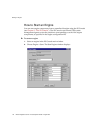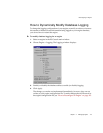
Monitoring and Changing Engine States
Chapter 4 Managing Engines 117
used process instances (and all their associated activities, timers, and process
attributes), until it brings the number of memory-resident process instances back
within the limit. The engine performs these checks periodically, as specified by the
value of the Swap-out Interval.
When a swapped-out process instance is subsequently needed, for example, to
change the state of an activity, to handle an expired timer, to evaluate an
assignment role, and so forth, the engine finds the process instance in the engine
database’s current state tables and swaps it back into memory.
In general, you want the value of the Swap-out Interval to be short enough so that,
under heavy load conditions, the number of process instances in memory cannot
grow to a point where the available memory resources are exceeded. However, if
you make the interval too short, the engine is incurring excessive overhead,
swapping more process instances out of and into memory than is needed.
Similarly, the value of the Memory-resident Process Limit must be set in
accordance with the memory required by executing process instances (which
depends on their complexity), the available memory resources, and the value of the
Swap-out Interval.
Despite the difficulty of determining the optimum values of each of these
configuration options, the combination provides great flexibility in tuning an
engine to process the heaviest loads, with the greatest performance, and with the
least risk of failure.
Monitoring and Changing Engine States
After you have started an engine, you should verify that it has started successfully
and monitor it periodically. In some situations, you may want to dynamically
change the state of engine components.
This section starts by describing how to monitor engines and engine components
with the iIS Console, followed by details on how to change engine states. For
information on how to perform these operations using Conductor Script, see
“Managing iIS Process Engines with Conductor Script” on page 235.
NOTE The evaluation of role-based assignment rules—as compared to
assignment rules that involve process attributes or linked
activities—does not require that the corresponding process instance
be resident in memory. Hence, much less swapping is generally
involved in executing process instances that employ only role-based
assignment rules.


















